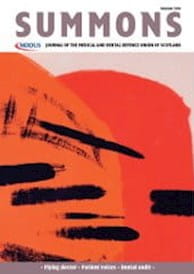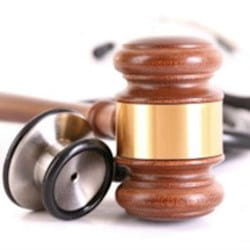IT’S SAFE to say that most emergency medicine consultants don’t travel to work in a helicopter and wear flame retardant flight suits and safety helmets. But for Dr Stephen Hearns, this kind of equipment is standard issue. As part of the specialist team of doctors who make up the Emergency Medical Retrieval Service (EMRS), Hearns and his colleagues must safely transfer critically ill patients in remote and rural areas in the west of Scotland to the nearest appropriate medical facility.
The married father-of-three works at the Royal Alexandra Hospital in Paisley and is lead consultant for EMRS. He has been an active member of Arrochar mountain rescue team for 13 years and also trained with the London Helicopter Emergency Medical Service. He helped set up EMRS in 2004 and has spent the past six years developing the service alongside his highly trained team mates.
EMRS won the prestigious 2010 BMJ Group Award for Secondary Care Team of the Year (sponsored by MDDUS) in March for its work in “transforming the care and transfer of seriously ill and injured patients in remote and rural Scotland”. The service operates from Stranraer in the south to Stornoway in the north of Scotland, but it is hoped it will one day operate on a national level. The signs are good as the Scottish Government announced in March that a second team would be added to EMRS from October 2010. This will increase the number of part-time consultants working on the team from 16 to 22 and they will cover all of remote and rural Scotland.
How did your interest in emergency medical retrieval develop?
As an emergency medicine trainee I became involved in mountain rescue medicine on a voluntary basis, organised medical cover for music festivals and acted as medical officer on a number of international expeditions. This gave me a taste for the challenges of providing emergency care to seriously injured or ill patients in difficult environments. I have always been interested in the management of serious problems which require quick thinking, a broad range of clinical skills and experience and an ability to lead a multi-disciplinary team in challenging circumstances. Extrapolating this approach to the care of patients at the roadside, on the mountainside, in a remote hospital or in a helicopter with limited equipment, investigations and assistance is a very rewarding experience.
I first witnessed helicopter retrieval when working in Australia and realised that this was what rural healthcare in Scotland needed. I was lucky enough to finish my specialist training with the helicopter emergency medical service in London which offers the best pre-hospital trauma care training in the world.
What prompted the establishment of the EMRS pilot programme?
A group of clinicians in hospitals in Glasgow and Paisley were becoming increasingly concerned about the poor state in which patients were arriving by aircraft from remote and rural facilities. Many had no chance of access to stabilisation procedures for many hours prior to their arrival in the urban hospital and their outcomes were poorer than would have been the case if they lived in an urban environment. Some clinicians had started to undertake ad-hoc retrievals with no supporting governance structure which was very hazardous.
In 2004 a group of 10 consultants established a voluntary but well-governed retrieval service for Argyll and Bute. Its aims were to improve rural patient care, support our rural colleagues, develop retrieval experience and show that rural retrieval was feasible and effective. Three years later the Scottish Government provided finance for a fully funded West of Scotland pilot service. This pilot earned a very positive independent review.
How is EMRS different from an air ambulance?
It is different in terms of staffing and skills. A standard air ambulance is crewed by paramedics. Our retrieval team is made up of a consultant, a trainee and a paramedic. We carry a portable emergency department resuscitation room with us including a ventilator, invasive monitoring capability and a near patient testing device. This allows us to undertake a broad range of stabilisation and monitoring interventions including emergency anaesthesia, ventilation, arterial blood pressure measurement, central venous press monitoring, chest drainage, drug infusions and cardiac pacing.
The capabilities in terms of assessment and management during an EMRS retrieval are therefore considerably more than that available during a standard air ambulance transfer. In addition the EMRS is actively involved in rural healthcare staff training and we provide expert advice over the phone regarding patient management and transport.
What kinds of medical problems do you most commonly deal with?
Two-thirds of our patients have medical emergencies such as respiratory failure, septic shock, cerebral haemorrhages, cardiac failure and severe overdoses. The remaining one-third have sustained major injuries.
What factors do you think made the EMRS pilot a success?
The success of the EMRS is down to the dedication and tenacity of the team. To man a 24/7 consultant rota voluntarily for three years demonstrated our commitment to providing a quality service. Our audit and research data proved that we improved outcomes. We also developed a robust external communications policy to highlight our work to the public, health service managers and to politicians through news coverage, our website, newsletters and taking every opportunity to speak at conferences and meetings relating to rural healthcare.
In addition we had excellent support from a number of healthcare managers and rural clinicians and directors who could see the value of our service from the outset.
What has been your most challenging case with EMRS?
A few cases stand out. One was dealing with a multiply injured man from a paragliding incident on a hillside above Loch Lomond in a primary retrieval combining the mountain rescue team, the EMRS and two helicopters. Another was dealing with a lady with multi-organ failure on an island who deteriorated just as we were about to move her. At the same time it was getting dark and a storm was coming in. This meant that the ambulance service helicopter had to leave us on the island. A few hours later when the patient was more stable we had to be transferred by search and rescue helicopter into a 50mph head wind and poor visibility.
What’s been your hairiest moment?
On attempting to reach Skye one winter’s night for a man with a serious head injury the search and rescue helicopter had to make an emergency landing on Mull due to smoke in the cockpit. The coastguard helicopter was dispatched to continue us on our journey but couldn’t land on Skye for over an hour due to a blizzard. The team ended up staying with the patient all night as the weather was too bad to get off the island.
What future do you see for the service?
Increasingly people are beginning to acknowledge the evidence that patients with major trauma have better outcomes with a specialist doctor and paramedic providing roadside pre-hospital medical care followed by direct transfer to a centre capable of providing definitive care. We are very keen that our secondary rural retrieval role expands to provide primary pre-hospital trauma care. Tasking the team appropriately for this role is however very challenging.
How do you spend your free time?
As well as time with my wife and three sons I enjoy a number of outdoor sports including mountaineering, road cycling sportive events and cross country mountain biking. Do you find it annoying when people go out in the hills unprepared? All mountain rescuers in Scotland are voluntary and unpaid. We enjoy training and undertake rescues no matter who or what is involved.
Most incidents occur because people are unlucky and many incidents could happen to anyone. It is slightly frustrating however when we have to rescue people who have set out too late in the day, have inadequate equipment and who can’t navigate to a basic level.
Interview by Joanne Curran, associate editor at MDDUS
This page was correct at the time of publication. Any guidance is intended as general guidance for members only. If you are a member and need specific advice relating to your own circumstances, please contact one of our advisers.
Read more from this issue of Insight

Save this article
Save this article to a list of favourite articles which members can access in their account.
Save to library
